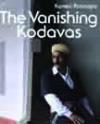The land of Kodagu or Coorg — the source of the river Cauvery — with its lush hills, forest streams and plentiful wildlife and flora has been home to the Kodavas, as well as a number of forest-dwelling tribes, since time immemorial.
Over the centuries, the hills hid the tiny region from the eyes of the world, offering the people the freedom to roam the dense forests they loved and respected as their home.
A student of social anthropology from the School of Oriental and African Studies, London, Kaveri Ponnapa spent 15 years researching The Vanishing Kodavas — crisscrossing the length and breadth of Kodagu, attending village festivals, participating in ceremonies propitiating ancestors, harvest festivals, marriages, deaths and ceremonies where the spirits of the ancestors speak through oracles. What struck her most poignantly was that with each passing year, there were fewer dancers, fewer singers and the voices of change were even more strident.

Her book, The Vanishing Kodavas, thus seeks to capture the spirit of a people and the motivations that shaped their traditions — the events that fashioned them and made them unique. The book is full of information — stories, myths and legends, the tragic history of the people, the poetic songs composed by rough warriors to whom routine violence was a way of life. As Ponnapa explains, “In a country as large as this one, small cultures tend to be overlooked or ‘lost’ quite easily. The Kodavas, one of the smallest groups, have contributed significantly to the country in many fields… There are many such small cultures like this one across the world that just add to the richness of human diversity…”
The book also explores the unique role the tiny kingdom of Kodagu, ruled by Lingayat rajas, supported by a council of Kodava chieftains, played in the rise of the East India Company in southern India. Until recently, these official manuals and gazetteers’ accounts, authored by missionaries and official historians of the East India Company written with an eye on official censorship, were the only source-books for most contemporary accounts of Kodagu’s history. They projected a completely distorted picture of the rajas of Kodagu portraying them as bloodthirsty tyrants, almost obliterating all memory of the loyalty and affection the people of Kodagu demonstrated time and again for their kings, over more than two centuries of their co-existence that survived only in the folk history of the land.
Using official records, correspondence, colonial accounts, the recorded history of the rajas of Kodagu and the oral histories of the Kodava people themselves and combining this with some 300 spectacular photographs, Ponnapa has created a rich and engrossing account of one of the most enigmatic people who have fascinated generations of scholars, administrators and anthropologists.
The easy narrative style of the book makes it accessible to a wide readership and the serious research that has gone into the writing makes it an important reference work on a fast disappearing culture and a base for further academic studies.
Ashwin Coelho is a social anthropologist
source: http://www.asianage.com / The Asian Age / Home> Books / by Ashwin Coelho /
September 22nd, 2013

